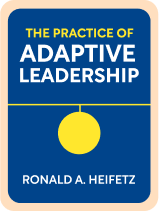

This article is an excerpt from the Shortform book guide to "The Practice of Adaptive Leadership" by Ronald A. Heifetz. Shortform has the world's best summaries and analyses of books you should be reading.
Like this article? Sign up for a free trial here .
What is adaptive leadership? What does “leading adaptively” entail in practice?
“Adaptive leadership” is marshaling people to tackle problems with unknown solutions and thrive while doing so. These problems with unknown solutions are called “adaptive challenges.” The only way to solve them is for the people in organizations to learn and change.
In this article, we’ll take a look at the qualities of adaptive leadership, the key activities inherent in addressing them, and some tips on how to lead adaptively.
The Qualities of Adaptive Challenges
Adaptive challenges have the following qualities:
Quality #1: They include an element of loss. Like biological adaptation, some things have to be left behind for things to change, but much will still be retained.
- (Shortform biological example: A white moth might evolve into a brown one (the moth loses a color it may have liked), but not into a unicorn (the moth’s core being is retained)).
- (Shortform business example: A struggling advertising firm might need to drop some existing clients to free up resources to take on new, more profitable clients. However, the firm doesn’t have to drop all its existing clients, change its staff, or change its industry.)
Quality #2: They include a human element. Problems are created by people, so everyone involved with the challenge will need to change.
- (Shortform example: If a call center’s adaptive challenge is customer dissatisfaction because the existing phone system keeps dropping calls, the people who use the phones will have to adapt in order to solve the problem, perhaps by learning to use a new phone system.)
Quality #3: They generate resistance. Some people will resist any sort of change because they fear the loss that comes with it—even the most seemingly dysfunctional workplace is working for some of the people in it. Others will agree that change is necessary but won’t agree on the best way to tackle the challenge. Even formal authority may not be enough to overcome this resistance.
- For example, if your adaptive challenge is to reduce staff turnover, you might ask a manager to give her desirable clients to up-and-coming salespeople to motivate them and encourage them to stick around. The up-and-coming people likely won’t resist, but the manager might, because she lost her favorite clients and her work is now harder.
Quality #4: They require spending time in the “productive zone of disequilibrium”—a zone in which a problem puts enough stress on people to motivate them to act, but not so much stress that they’re overwhelmed and can’t do anything at all.
- (Shortform example: If one of your competitors is growing quickly, but to stay ahead you would have to do something you don’t want to—say, scrap a legacy project and develop something new—it will be most comfortable to ignore the threat and do nothing. It will be most chaotic to abandon everything you’re currently doing and start from scratch. The productive zone of disequilibrium is somewhere in between.)
Quality #5: They take a long time to solve and require experimentation and iteration. Since there’s no known solution, you’re going to have to try different things, and inevitably, not everything you try will work.
- For example, at a company experiencing high turnover, a manager might try increasing bonuses to encourage people to stay. However, achieving high bonuses makes employees more attractive to other companies, which could actually increase turnover.
The Key Activities of Facing Adaptive Challenges
There are three key activities to engage in to understand adaptive challenges: observing, interpreting, and intervening. You’ll need to do all of them multiple times—as you interpret your observations, you may make new observations, and after intervening, you’ll need to observe the results to decide on your next intervention.
Activity #1: Observation
Observation is assessing the circumstances surrounding the challenge, and the challenge itself, as objectively as possible. To do that:
1. Get as much information as you can from all available sources. Research, talk to people, and pay attention to your surroundings.
2. Get some distance from the challenge. When you’re deeply involved in a situation, it’s difficult to see things that aren’t right in front of you, so step away and try to see the whole picture.
- For example, in a meeting, you might sit in the back and take notes on what happens rather than participating.
We’ll look at observation in more detail in Part 2.
Activity #2: Interpretation
Interpretation is attaching meaning to what you’ve observed—describing events rather than simply reciting them.
Your brain will interpret things (such as adaptive problems) unconsciously, and often in a biased way. When you mentally write a story to explain what you’re seeing, you, like most people, will include details and facts that support your favorite interpretation, and leave out ones that don’t. Typically, your favorite interpretation will be one that shows you in a good light and justifies your behavior. As a result, you may misinterpret adaptive problems and your own role in them.
- For example, two people might observe the same thing in a meeting—a quiet, African American woman is regularly interrupted while speaking. One person might interpret this as the group being prejudiced and devaluing the woman’s opinion. Another person (perhaps one of the people who interrupted her) might interpret this as her being soft-spoken.
To regain some control of your brain and its interpreting tendencies and ensure that you interpret situations as objectively as possible:
1. Question the accuracy of your interpretation—acknowledge that interpretations are made up of assumptions. When you and others observe the same events, consider their versions of the story.
2. Come up with as many interpretations as possible. The more angles and perspectives you can see a situation from, the more complete your picture of it will be.
3. Try to hold more than one interpretation in your mind simultaneously. This will allow you to stay open to new information: You’ll be open to information about multiple interpretations, not just one.
We’ll look more at interpretation in Part 3.
Activity #3: Intervention
Intervention is coming up with a plan of action to address your challenge, based on your interpretation of its causes and intricacies. We’ll look more at interventions (also called change initiatives) in Part 3.
Adaptive Leadership Is Dangerous
Since adaptive problems don’t have known solutions, you won’t be able to fix them by following pre-existing directions of the people who give you authority. Therefore, adaptive leadership is dangerous—by nature, it involves challenging the expectations of the very people who gave you power.
- For example, if a company hired you to run a department, they’ll want you to follow their directions and run the department in the way they expect. They’ll expect you to stay within your scope of authority and defer to them, even if running the company in the way they expect isn’t effective. Thus, changing your leadership style to face an adaptive challenge may upset your superiors.
Practice Adaptive Leadership to Achieve a Purpose
Since adaptive leadership will make people resist you and potentially jeopardize your job, it’s only worth practicing when it will help you or your organization achieve a compelling purpose.
Purposes are the causes that bring value, happiness, or meaning to you or your organization. You and your organization probably have many purposes, all of which are important, but one of them is most important (called the “orienting purpose”). Once you know this purpose, you can use it to guide daily decisions, time and resource allocation, and risk assessment.
To determine what your or your organization’s orienting purpose is:
1. Assess actions rather than words. What you do is a better indication of what you most value than what you say. If your words and actions don’t match up, contemplate the dissonance.
- (Shortform example: If your organization claims to value the environment but allocates most of its donation budget to human rights charities, the organization probably values human rights most.)
2. Consider what you or your organization are willing to take risks to do.
- For example, Max had a good job on the East Coast, but his girlfriend lived on the West Coast. He took the risk of moving to be with her, which demonstrated that he valued his relationship over his career at that moment.
3. Ask yourself or your organization what you’re ultimately trying to do. This will give you an abstract, high-level purpose that you work backward from to figure out your more concrete orienting purpose. Whenever you contemplate taking an action, ask yourself if it will further your high-level purpose, and if it does, it’s a clue to what your specific, orienting purpose might be.
- (Shortform example: If your ultimate goal is to “save the planet,” ask yourself what action you could take to do that—perhaps you might start a company that builds electric cars, and your purpose becomes to sell a lot of electric cars.)
Trying to hold multiple orienting purposes or compromise your purposes usually doesn’t work—if you try to achieve too many purposes, you’ll run thin and won’t achieve any of them.
- For example, when Marty was the editor of a newspaper, many of the writers wrote critical articles about a real estate developer. The developer was one of Marty’s friends, and he told Marty that he had to shut down the articles or they couldn’t be friends anymore. Instead of choosing between the conflicting purposes of journalistic integrity and friendship, Marty tried editing the articles to make them less critical. He lost face as the editor and his friend dropped him anyway.
Though you and your organization can’t hold multiple orienting purposes at once, your orienting purpose can change. You can also delegate purposes to others temporarily if needed.
- For example, there may be moments when your family requires your attention and you need to focus on them instead of your work.

———End of Preview———
Like what you just read? Read the rest of the world's best book summary and analysis of Ronald A. Heifetz's "The Practice of Adaptive Leadership" at Shortform .
Here's what you'll find in our full The Practice of Adaptive Leadership summary :
- How to deal with unknown solutions that require innovation, experimentation, and adaptation
- How to determine if a problem is technical or adaptive
- Five tips for launching initiatives to address adaptive challenges






